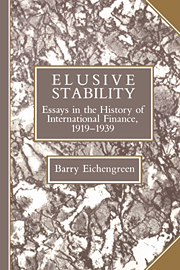Book contents
- Frontmatter
- Contents
- List of tables
- List of figures
- Acknowledgments
- 1 Introduction
- 2 Real exchange rate behavior under alternative international monetary regimes
- 3 Understanding 1921–1927: inflation and economic recovery in the 1920s
- 4 Bank Rate policy under the interwar gold standard
- 5 The Bank of France and the sterilization of gold, 1926–1932
- 6 International policy coordination in historical perspective: a view from the interwar years
- 7 The economic consequences of the franc Poincaré
- 8 Sterling and the tariff, 1929–1932
- 9 Exchange rates and economic recovery in the 1930s
- 10 The gold-exchange standard and the Great Depression
- 11 Hegemonic stability theories of the international monetary system
- References
- Index
4 - Bank Rate policy under the interwar gold standard
Published online by Cambridge University Press: 21 March 2010
- Frontmatter
- Contents
- List of tables
- List of figures
- Acknowledgments
- 1 Introduction
- 2 Real exchange rate behavior under alternative international monetary regimes
- 3 Understanding 1921–1927: inflation and economic recovery in the 1920s
- 4 Bank Rate policy under the interwar gold standard
- 5 The Bank of France and the sterilization of gold, 1926–1932
- 6 International policy coordination in historical perspective: a view from the interwar years
- 7 The economic consequences of the franc Poincaré
- 8 Sterling and the tariff, 1929–1932
- 9 Exchange rates and economic recovery in the 1930s
- 10 The gold-exchange standard and the Great Depression
- 11 Hegemonic stability theories of the international monetary system
- References
- Index
Summary
In truth, the gold standard is already a barbarous relic. All of us, from the Governor of the Bank of England downwards, are now primarily interested in preserving the stability of business, prices, and employment, and are not likely, when the choice is forced upon us, deliberately to sacrifice these to the outworn dogma, which had value once, of £3. 17s. 10½d. per ounce.
J. M. KEYNES (1923), p. 172The classical gold standard occupies an almost mystical position in the literature of international finance. In popular accounts the gold standard is portrayed as a remarkably durable and efficient mechanism for achieving price and exchange rate stability and for relieving balance of payments pressures. The system's resilience is attributed to the willingness of national monetary authorities to refrain from impeding the international adjustment process. When central banks intervened in financial markets, it is said, they did so mechanically, obeying ‘rules of the game’ which dictated that they reinforce the impact on domestic money and credit of changing balance of payments conditions.
Succeeding generations of economists and historians have sought to qualify this popular view. The recent contributions of Bordo (1981) and Cooper (1982) provide a critical assessment of extravagant claims concerning price and exchange rate stability under the classical gold standard. Other authors have extended the research of Bloomfield (1959), Ford (1962), and Triffin (1964), who emphasized the special conditions that permitted the classical gold standard's smooth operation and cast doubt on the tendency of national monetary authorities to adhere faithfully to ‘rules of the game.’
- Type
- Chapter
- Information
- Elusive StabilityEssays in the History of International Finance, 1919–1939, pp. 57 - 82Publisher: Cambridge University PressPrint publication year: 1990



